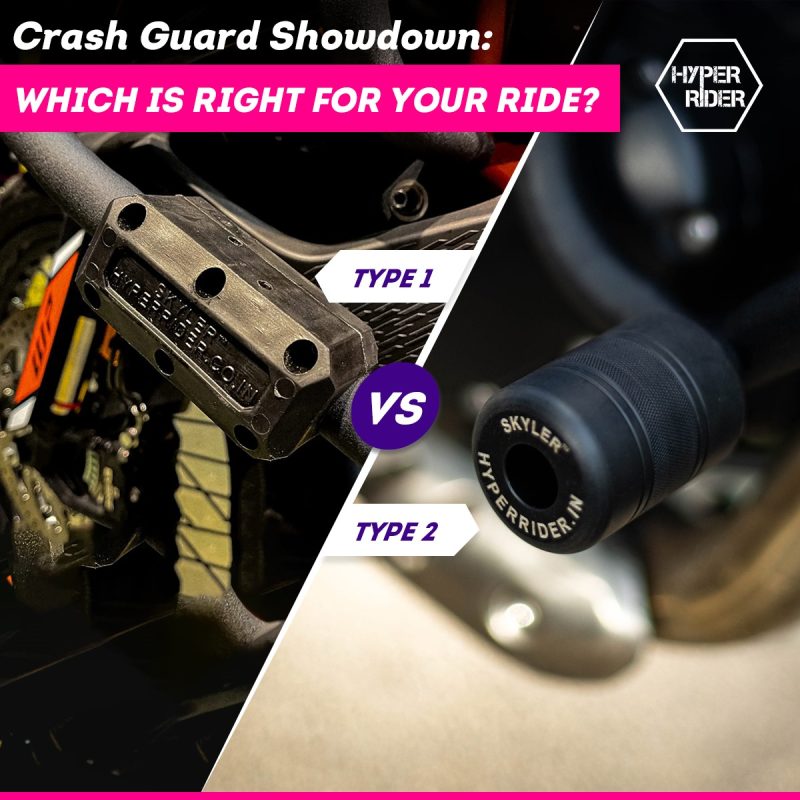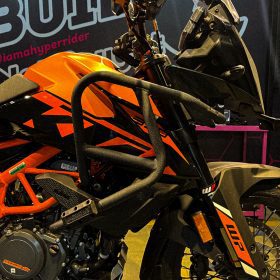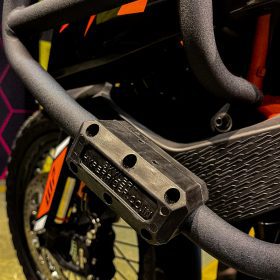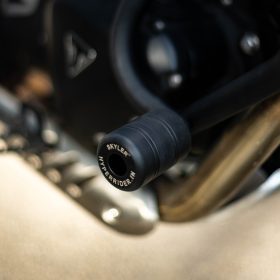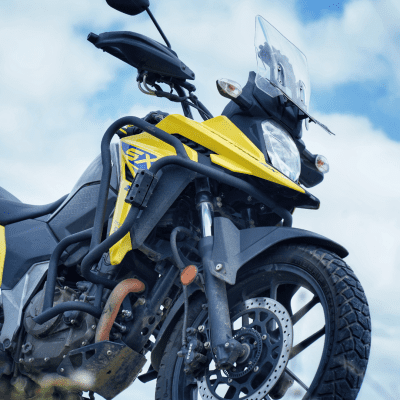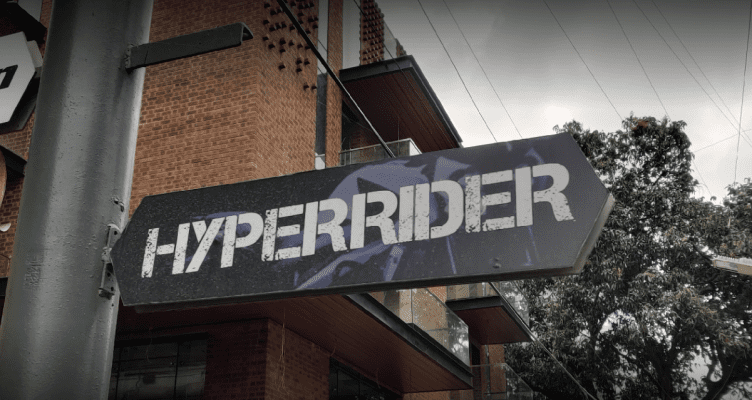Bike Accessories - Blogs, Riding Adventure, Safety Gear
Crash Guard Showdown: Type 1 vs. Type 2 – Which is Right for Your Ride?
Introduction:
Riding a motorcycle is the epitome of freedom. But with that freedom comes responsibility, and one crucial aspect is safety. Accidents happen, and when they do, even the most skilled rider can benefit from additional protection. Enter the humble crash guard – your bike’s guardian angel in a slip-and-slide scenario.
Crash guards come in various forms, but two primary types dominate the landscape: Type 1 and Type 2. Understanding their differences is key to ensuring your steed is optimally protected for your riding style.
Importance of Crash Guards for Motorcycle Safety:
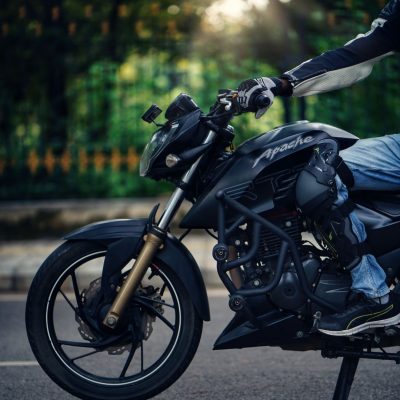
Let’s face it, motorcycles are exposed machines. A simple tip-over or low-speed tumble can result in costly damage to your bike’s fairing, engine, and other vital components. This, in turn, translates to downtime and repair bills. Crash guards act as a sacrificial barrier, absorbing the brunt of the impact and shielding these vulnerable areas. They can also save you from painful skin abrasions and potentially more serious injuries in certain situations.
Overview of Crash Guard Type 1 and Crash Guard Type 2:
While both types offer protection, their approaches differ:
Crash Guard Type 1:
Think lightweight and nimble. These guards are constructed from aluminum or steel tubing and typically mount to existing frame points. Their minimalist design offers adequate protection for city commuting and occasional light off-road ventures. They’re a great balance between protection and maneuverability, keeping your wallet happy without adding too much bulk.
Crash Guard Type 2:
These are the heavy hitters of the crash guard world. Built with robust steel or composite materials, they boast a multi-point mounting system for unparalleled rigidity. This translates to superior protection for adventure touring and serious off-road riding. Expect additional brackets and sub-frames for increased stability, a testament to their ability to handle significant impacts and rollovers.
Understanding the Crash Guard Type 1 for Different Riding Styles
Feature |
Crash Guard Type 1 |
| A. Design and Features: | |
| * Material and Construction: |
|
| * Mounting Mechanism: |
|
| B. Suitable Riding Styles: | |
| * City Commuting: |
|
| * Light Off-road Riding: |
|
| * Adventure Touring: |
|
| * Off-road Riding: |
|
| C. Pros and Cons: | |
| * Advantages: |
|
| * Limitations: |
|
| D. Comparison of Riding Styles: | |
| * City Commuting: |
|
| * Light Off-road Riding: |
|
| * Adventure Touring: |
|
| * Off-road Riding: |
|
Understanding the Crash Guard Type 2 for Different Riding Styles
Feature |
Crash Guard Type 2 |
| A. Design and Features: | |
| * Material and Construction: |
|
| * Mounting Mechanism: |
|
| B. Suitable Riding Styles: | |
| * City Commuting: | ·
|
| * Light Off-road Riding: |
|
| * Adventure Touring: |
|
| * Off-road Riding: |
|
| C. Pros and Cons: | |
| * Advantages: |
|
| * Limitations: |
|
| D. Comparison of Riding Styles: | |
| * City Commuting: |
|
| * Light Off-road Riding: |
|
| * Adventure Touring: |
|
| * Off-road Riding: |
|
Conclusion:
Navigating the world of crash guards can be like choosing a knight’s armor. Finding the right fit depends on your riding style and the perils you anticipate encountering.
Recap of Key Differences:
Material:
- Type 1 – Lighter (aluminum/steel tubing),
- Type 2 – Heavy-duty (steel/composite)
Design:
- Type 1 – Simpler,
- Type 2 – Reinforced for high impact
Mounting:
- Type 1 – Two/three-point
- Type 2 – Multi-point for rigidity
Suitability:
- Type 1 – City commuting, light off-road,
- Type 2 – Adventure touring, off-road riding
Pros:
- Type 1 – Lightweight, affordable, compact
- Type 2 – Superior protection, confidence, durable
Cons:
- Type 1 – Less protection, not ideal for all styles
- Type 2 – Heavier, more expensive, bulkier
Recommendations based on Riding Style and Preference:
City Commuter:
- Type 1 offers ample protection without sacrificing agility.
Light Off-road Rider:
- Type 1 for occasional trials,
- Type 2 for frequent/challenging outings.
Adventure Tourer:
- Type 1 for gentle gravel roads
- Type 2 is essential for demanding conditions.
Serious Off-roader:
- Type 2 is your best friend for tackling tough terrain.
Final Thoughts:
Remember, crash guards are an investment in your safety and your bike’s well-being. Choose wisely based on your needs and don’t let price be the sole deciding factor. A well-protected motorcycle is a happy motorcycle, and a happy motorcycle translates to more miles of wind-in-your-hair freedom. So, suit up, gear up, and ride confidently knowing you’ve got a guardian angel guarding your two-wheeled chariot.
Crash Guard Showdown: Type 1 vs. Type 2 – Which is Right for You? Hyperrider – The Bike Accessories. We hope this content provides a clear and engaging overview of crash guard types and empowers you to make an informed decision for your motorcycle’s safety and peace of mind. Happy riding!
Explore Our Bike Accessories in Various Brand Collections at Hyperrider
Also, follow our Instagram page Hyperrider
Powder Coated
Hyperrider Products are powder-coated to resist corrosion. Watch our quality videos on YouTube.
1 Year Warranty
Hyperrider-manufactured products have 1 Year warranty. See the Warranty and Claim section for details.

